MRI for assessment of anal fistula
- PMID: 22347906
- PMCID: PMC3259332
- DOI: 10.1007/s13244-010-0022-y
MRI for assessment of anal fistula
Abstract
Magnetic resonance imaging (MRI) is the best imaging modality for preoperative assessment of patients with anal fistula. MRI helps to accurately demonstrate disease extension and predict prognosis. This in turn helps make therapy decisions and monitor therapy. The pertinent anatomy, fistula classification and MRI findings will be discussed.
Figures

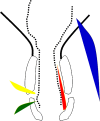




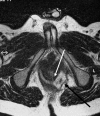
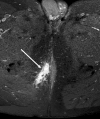


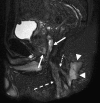


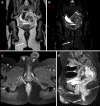

Similar articles
-
Evaluating postoperative anal fistula prognosis by diffusion-weighted MRI.Eur J Radiol. 2020 Nov;132:109294. doi: 10.1016/j.ejrad.2020.109294. Epub 2020 Sep 21. Eur J Radiol. 2020. PMID: 33038577
-
The contribution of preoperative MRI to the surgical management of anal fistulas.Diagn Interv Radiol. 2018 Nov;24(6):321-327. doi: 10.5152/dir.2018.18340. Diagn Interv Radiol. 2018. PMID: 30272562 Free PMC article.
-
Endoanal ultrasound or magnetic resonance imaging for preoperative assessment of anal fistula: a comparative study.Colorectal Dis. 2001 May;3(3):189-97. doi: 10.1046/j.1463-1318.2001.00241.x. Colorectal Dis. 2001. PMID: 12790988
-
Guidelines on postoperative magnetic resonance imaging in patients operated for cryptoglandular anal fistula: Experience from 2404 scans.World J Gastroenterol. 2021 Sep 7;27(33):5460-5473. doi: 10.3748/wjg.v27.i33.5460. World J Gastroenterol. 2021. PMID: 34588745 Free PMC article. Review.
-
Rectal imaging: part 2, Perianal fistula evaluation on pelvic MRI--what the radiologist needs to know.AJR Am J Roentgenol. 2012 Jul;199(1):W43-53. doi: 10.2214/AJR.11.8361. AJR Am J Roentgenol. 2012. PMID: 22733931 Review.
Cited by
-
Congenital Cheek Fistula: A Rare Case of Developmental Abnormality in the Buccal Area.Cureus. 2021 Jun 15;13(6):e15657. doi: 10.7759/cureus.15657. eCollection 2021 Jun. Cureus. 2021. PMID: 34277250 Free PMC article.
-
Evaluation of the Effectiveness of a Combination of Chinese Herbal Fumigation Sitz-Bath and Red Ointment in Managing Postoperative Wound Healing and Pain Control in Anal Fistula Patients.Contrast Media Mol Imaging. 2022 Sep 15;2022:1905279. doi: 10.1155/2022/1905279. eCollection 2022. Contrast Media Mol Imaging. 2022. Retraction in: Contrast Media Mol Imaging. 2023 Aug 2;2023:9767098. doi: 10.1155/2023/9767098. PMID: 36176927 Free PMC article. Retracted. Clinical Trial.
-
Factors Increasing the Risk of Recurrence in Fistula-in-ano.Cureus. 2019 Mar 7;11(3):e4200. doi: 10.7759/cureus.4200. Cureus. 2019. PMID: 31114719 Free PMC article. Review.
-
Development and validation of the MRI-based deep learning classifier for distinguishing perianal fistulizing Crohn's disease from cryptoglandular fistula: a multicenter cohort study.EClinicalMedicine. 2024 Nov 22;78:102940. doi: 10.1016/j.eclinm.2024.102940. eCollection 2024 Dec. EClinicalMedicine. 2024. PMID: 39640934 Free PMC article.
-
Prognostic factors affecting outcomes in fistulating perianal Crohn's disease: a systematic review.Tech Coloproctol. 2017 Jul;21(7):501-519. doi: 10.1007/s10151-017-1647-3. Epub 2017 Jun 20. Tech Coloproctol. 2017. PMID: 28639073 Free PMC article.
References
LinkOut - more resources
Full Text Sources
